World Cup (cricket): history
This series of articles is mainly about the World Cup insofar as it concerns South Asia. Mentions of other countries' performances are mainly limited to their performance in the finals and their performance against South Asian countries.
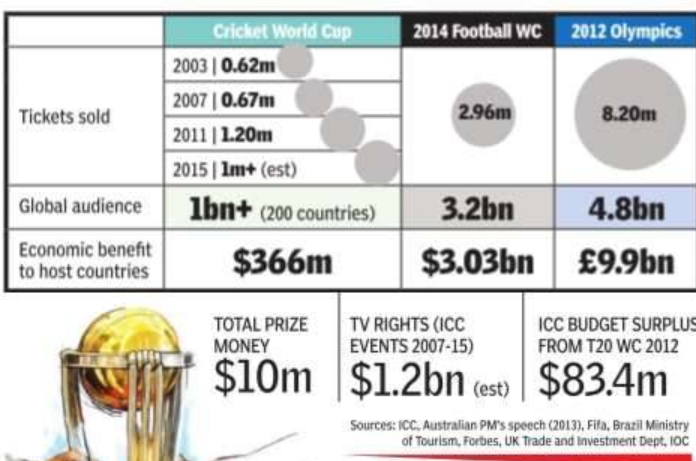
This is a collection of articles archived for the excellence of their content. |
Contents |
The sources of this article include...
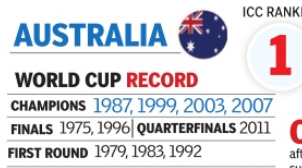
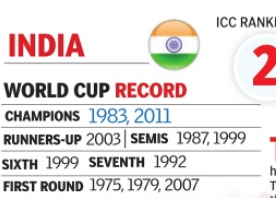
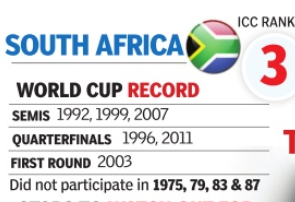
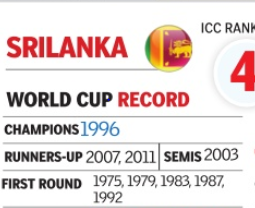
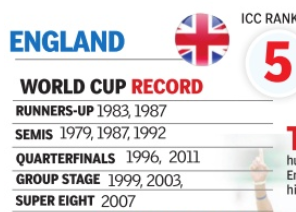
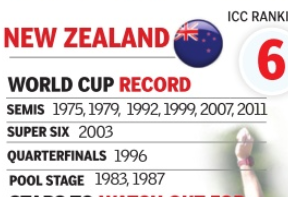
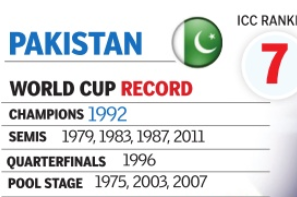
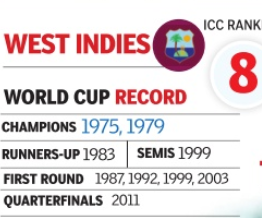
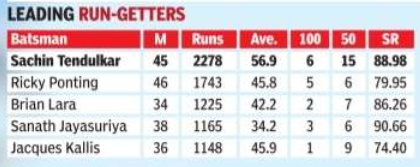
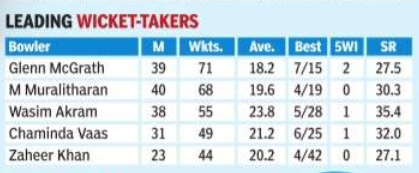
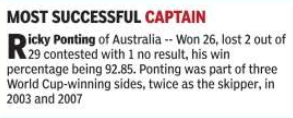
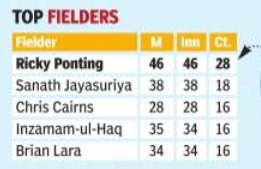
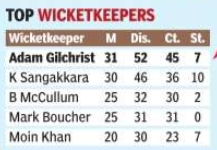

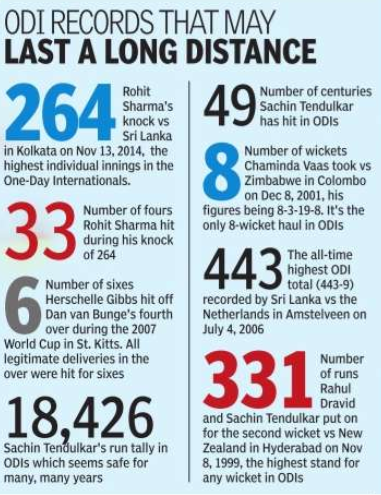
Nalin Mehta,TNN | Feb 8, 2015 The Times of India World Cup: What all has changed from 1975 to 2015 <>The Times of India Brief history of the World Cup
1975
The first Men's Cricket World Cup (Prudential Cup): venue England
Number of overs per team: 60
Uniform: white
Colour of balls: red.
Hours of play: daytime.
Participating teams: 6 test playing teams (Australia, England, India, Pakistan, New Zealand the West Indies) plus 2 (Sri Lanka, East Africa) = 8 in all
Winners: West Indies defeated Australia in the finals.
The indomitable Windies, led by Clive Lloyd, took to the format like ducks to water.The skipper himself rose to the task in the final, scoring 102 from 85 balls as the Windies scored 2918 off 60 overs. Viv Richards effected three run outs and in spite of Ian Chappell's fighting 62 the Aussies managed only 274. The dramatic finale made the One-day format hugely popular.
Nalin Mehta’s insight [1]
1975 The first cricket World Cup in 1975 was not even called the World Cup. With only 15 games and a new one-day format that everyone still saw as a "necessary evil" that followed Test matches, insurance-giant Prudential insisted as tournament sponsor that it be called the Prudential Cup.
And so it was, on the silver trophy that Clive Lloyd eventually held aloft and even in the game's bible, Wisden. Yet, charting the early history of the World Cup, cricket writer and historian Gideon Haigh argues the idea was a huge success because "like the best innovations, cricket's World Cup met a need nobody had foreseen." It fulfilled the eternal need of sports fans to dramatically square off their teams and see who was best: in a way that geeky and constantly oscillating rankings could never hope to match.
1979
Prudential Cup: venue England
All 6 test playing teams participated.
Through the ICC Trophy competition, two non-Test playing teams were selected for the World Cup: Sri Lanka and Canada.
Winners: West Indies, who defeated England in the finals.
1983
Prudential Cup: venue England
Participating teams: All seven test playing teams (now including Sri Lanka), plus Zimbabwe (selected through the ICC Trophy)
Winners: India, who defeated West Indies in the finals.
1987
No longer called Prudential, the 1987 Cricket World Cup was co-hosted by India and Pakistan.
It was now the Reliance World Cup
Number of overs: 50
Participating teams: 8 (Australia, England, India, New Zealand, Pakistan , Sri Lanka, West Indies, Zimbabwe)
Winners: Australia, who defeated England.
1992
Venue: Australia and New Zealand
Uniform of players: A different coloured uniform for each eam
Colour of balls: white
Hours of play: day/night
Participating teams: Participating teams: Australia, England, India, New Zealand, Pakistan, South Africa, Sri Lanka, West Indies , Zimbabwe
South African participated for the first time.
Winners: Pakistan, defeating England in the finals.
1996
The Wills World Cup
Venue: The Indian subcontinent (India, Pakistan and Sri Lanka)
Participating teams: Australia, England, India, Kenya, the Netherlands, New Zealand, Pakistan, South Africa, Sri Lanka, United Arab Emirates, the West Indies, Zimbabwe
Kenya and Zimbabwe were included.
Winners: Sri Lanka, defeating Australia in the final.
1999
Venue: The United Kingdom (mainly England but also Ireland and Scotland) and the Netherlands.
Participating teams: twelve (as below).
Full Members: Australia, England, India, New Zealand, Pakistan, South Africa, Sri Lanka, the West Indies, Zimbabwe
Associate Members: Bangladesh, Kenya, Scotland
Winners: Australia, who defeated Pakistan in the final.
2003
Venue: South Africa, Zimbabwe and Kenya.
Participating teams: fourteen (as below):
Full Members: Australia, Bangladesh, England, India, New Zealand, Pakistan, South Africa, Sri Lanka, the West Indies, Zimbabwe.
Associate Members: Canada, Kenya, Namibia, the Netherlands.
Winners: Australia, which defeated India in the finals.
2007
Venue: the West Indies.
Participating teams: sixteen (as below):
Full Members: Australia, Bangladesh, England, India, New Zealand, Pakistan, South Africa, Sri Lanka, the West Indies, Zimbabwe
Associate Members: Bermuda, Canada, Kenya, Ireland, the Netherlands, Scotland
Winners: Australia, which defeated Sri Lanka in the final.
2011
Venue: The Indian sub-continent (India; Sri Lanka; Bangladesh). The International Cricket Council (ICC) removed Pakistan from the list of co-hosts after the 2009 attack on the Sri Lankan national cricket team in Lahore.
Participating teams: fourteen (as below):
Full Members: Australia, Bangladesh, England, India, New Zealand, Pakistan, South Africa, Sri Lanka, the West Indies, Zimbabwe
Associate Members: Canada, Ireland, Kenya, Netherlands
Winners: India, who defeated Sri Lanka in the final.
2015
Venue: Australia and New Zealand.
Participating teams: 14 (Afghanistan, Australia, Bangladesh, England, India, Ireland, New Zealand, Pakistan, Scotland, South Africa, Sri Lanka, United Arab Emirates, West Indies, Zimbabwe)
Nalin Mehta’s insights [2]
2015 Cricket's World Cup 2015 is very different from its first edition. Starting on Valentine's Day with 42 matches over 43 days, 14 teams and an estimated global TV audience of over 1 billion, it may be dwarfed in size by the Olympics or the soccer World Cup but remains the holy grail of the cricketing world and generates significant business, much of it in India.
With Amitabh Bachchan sitting in the commentary box for the India-Pakistan game and commentary also in regional languages, it also promises to be a different viewing experience, reflective as much of India's madness for the game as that madness shaping it.
There is a reason why the tournament's first half in the group stages is essentially predictable: to ensure against an early exit by India or any of the big teams. Organizers and sponsors know what happened in 2007 when India and Pakistan crashed out of the Caribbean World Cup early. It killed TV interest in India and ruined the business that sustains such events. In 2015 everyone waited for the quarterfinals when the big games really began.
Australia has always been seen as the land of pace and bounce, and New Zealand of seam and swing. Five of seven knockout games in this World Cup, therefore, were played on drop-in pitches, curated away from the venue and dropped in before the games, which significantly reduced the special peculiarity of local playing-conditions. The advent of pre-fabricated surfaces even prompted one Australian writer to call the tournament a "rental World Cup".
The other big change from the 2011 World Cup is the introduction of two new balls: one from each end. This is a good move aimed at checking the batting bias in one-day internationals (ODIs), with batsmen scoring more and more runs in each edition of the World Cup. The 1996 and 1999 editions produced over 14,000 runs each, but from 2003 onwards, each World Cup had produced over 18,000 runs. The two new balls rule was expectedto aid fast bowlers but may also diminish the role of spinners. India, with its mediocre bowling attack, for example, faced an uphill task.
A 2007 [Indian] legislation mandated compulsory telecasts of Indian cricket matches on public broadcaster Doordarshan (DD), irrespective of whether it had bought rights or not, the tortuous travails of legal cricketing battles around TV have been almost riveting as those on it. In 2015, Delhi High Court weighed in, ruling that DD can only show the matches on its terrestrial network, not on its channels compulsorily carried on cable and satellite.
Taking into account the huge money paid by broadcaster Star India for these matches, a bench of Justices B D Ahmed and Vibhu Parekh ruled that the law meant to provide "access to the largest number of viewers, on a free-to-air basis" and its ruling seeks to balance these two factors. "There is no change in law as a result of this," says a Star India spokesperson. "However, the implementation of this Act till now was flawed as these events of national importance were available to private cable and DTH operators as well. The High Court has only held that this is incorrect per the Act."
After a year in which the ODI ratings consistently lagged behind those for T20 ratings and the ODI-format itself faced questions, the World Cup 2015 was expected to give it a fillip. In 2014, peak ratings for ODI series dipped to 2.0 TVR (compared to 3.9-4.1 in 2011-13).
Whether it was Kapil running backwards for an eternity from mid-on to send Viv Richards back in the 1983 finals or Imran's famous pep-talk in his "ready-to-pounce" T-shirt in 1992, every World Cup brings with it its own legend. In 2011, it was about Sachin and the palpable desperation of one man for the Cup that animated India.
Fascinating facts about World Cups
Author: MS Ramakrishnan, Bangalore, Thu, Jan 22 2015 CricBuzz 1 <>CricBuzz 2 <>CricBuzz 3 <>CricBuzz 4 <>CricBuzz 5
1977: The revolution of ODI cricket Many top cricketers turned pirate with the inception of the Kerry Packer series in 1977. It was this series which paved way for the modernization of ODI cricket with coloured clothing and floodlit fixtures coming on later. Eventually, since 1992, teams began to the play the World Cup with coloured clothing and white cricket balls.
Man of the Match awards: Men for the big occasion Mohinder Amarnath (1983), Aravinda De Silva (1996) and Shane Warne (1999) hold the unique record of winning Man of the Match awards in both semifinal and final of the World Cup games.
Bowling averages: The best and worst bowling average Pakistani batsman Mohammad Yousuf has the best bowling average (0.00) in World Cup history. Yousuf took the wicket of Zimbabwe's Christopher Mpofu with the very first ball he bowled in the 2007 World Cup. Contrastingly, New Zealand off-spinner John Bracewell has the worst average. Featuring in two World Cups (1983, 1987), Bracewell played seven matches, conceded 310 runs and picked up just 1 wicket, meaning he had an average of 310.
Highest run-getter in World Cups During his knock of 52 against the Netherlands in the 2003 World Cup, Sachin Tendulkar surpassed Javed Miandad (1083) to become the highest run-getter in World Cup history. Eventually, Tendulkar finished with 2278 runs in World Cups.
Youngest World Cup winner Aged 22 years and 3 months, Piyush Chawla was the youngest to taste World Cup success when MS Dhoni's devils defeated Sri Lanka in Mumbai in 2011.
Highest (cumulative) number of runs scored in all World Cup matches put together 2278 Runs scored by Sachin Tendulkar in 45 matches, the most in Cup history. The Times of India
Highest individual score 188: by South Africa's Gary Kirsten against UAE in '96 The Times of India
Highest (cumulative) number of wickets taken in all World Cup matches put together 71 Wickets by Australia's Glenn McGrath in 39 games, the most in WCs The Times of India
See also
World Cup (cricket): history <>World Cup (cricket): 1975 <>World Cup (cricket): 1979 <>World Cup (cricket): 1983 <>World Cup (cricket): 1987 <>World Cup (cricket): 1992 <>World Cup (cricket): 1996 <>World Cup (cricket): 1999 <>World Cup (cricket): 2003 <>World Cup (cricket): 2007 <>World Cup (cricket): 2011 <>World Cup (cricket): 2015